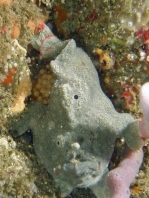
 www.frogfish.ch
www.frogfish.ch

Porophryne erythrodactylus
Bare Island Anglerfish (Red-footed Frogfish, Sydney Frogfish)
Bare Island Anglerfisch (Rotfuss Anglerfisch, Sydney Anglerfisch)
(Arnold, Harcourt & Pietsch, 2014)
All frogfish-species (list / color / image) - Alle Anglerfisch-Arten (Liste / Farben / Bild)
| This small frogfish is known
only from the area around Bare Island in Botany Bay (New South Wales). |
|
Dieser winzige Anglerfisch ist
nur von der Gegend um Bare Island in der Botany Bay (New South Wales)
bekannt. |
|||||||||||||||||||||||||||||||||||||||
Porophryne erythrodactylus Copyright Doug Anderson (Flickr), Bare Island, Australia
Two color variations with grey on the left
und redish on the right
I think the name "Red footed frogfish" or "Redfingered frogfish" would be appropriate
because this is the only frogfish with a red edge around its foot (which is actually a pelvic or pectoral fin)
Eggs hidden behind the body of the Bare Island Frogfish - Eier
hinter dem Körper des Bare Island Anglerfisches versteckt
Characteristics - Porophryne erythrodactylus - Merkmale |
|||||||||||||||||||||||||||||||||||||||||
| Illicium
and Esca: Illicium (rod) is as long as second dorsal spine. The esca (lure, bait) is large and oval shaped with two tufts of short filaments. Additional Characteristics: On the midline of the lip of the lower jaw is a tuft of filaments, brightly colored. The second dorsal fin is thick and not connected to the head with a membrane (similar to Kuiterichthys furcipilis). Shades of gray. The fins have a red-orange margin. This anglerfish has a bumpy skin with some osculum-like spots on the sides of the body. More Information: New molecular findings show that this species is closely related Kuiterichthys (Pietsch, Arnold 2012 / Arnold, Harcourt & Pietsch, 2014). New photos show that this species lays eggs!! |
|
Illicium
und Esca: |
|||||||||||||||||||||||||||||||||||||||
Habitat - Porophryne erythrodactylus - Lebensraum |
|||||||||||||||||||||||||||||||||||||||||
| On sponges. 6-14m |
Auf Schwämmen. 6-14m | ||||||||||||||||||||||||||||||||||||||||
Range - Porophryne erythrodactylus - Verbreitung |
|||||||||||||||||||||||||||||||||||||||||
| New South Wales,
southern
Australia (Botany Bay, Sydney Harbour, Bare Island, Jervis Bay). |
New South Wales, Süd-Australien
(Botany Bay, Hafen von Sydney, Bare Insel, Jervis Bay). |
||||||||||||||||||||||||||||||||||||||||
Photos - Porophryne erythrodactylus - Fotos
New photos show that this species lays eggs!! - Neue Fotos zeigen, dass diese Art Eier legt!!
Porophryne erythrodactylus Copyright Dr. Torsten Thomas, Bare Island, La Perouse, Sydney, Australia
Porophryne erythrodactylus Copyright Tomas Mitchell
Baby Anglerfish sitting very high on a brightly colored sponge,
fishing. The juvenile moves around a lot, changes his positions
all the time whereas adults tend to sit on the same spots for
longer periods of time. |
|||||||||||||||||||||||||||||||||||||||||
| This angler also moves the knob-like
protrusion it has in its mouth a lot, it is like a small rod with
bait at the end and it makes quivering movements with it (observation
by Galina Della Ross). See also this text
with photos / flap of the Hispid
frogfish. |
Dieser Angler scheint auch sehr
oft den kleinen Hautfetzen, den er im Mund hat zuckend zu bewegen,
fast wie ein Köder (Beobachtungen von Galina Della Ross). Siehe
auch dieser Text
mit Fotos. / Hispid
Anglerfisch mit kleinen weissen Hautlappen |
||||||||||||||||||||||||||||||||||||||||



































